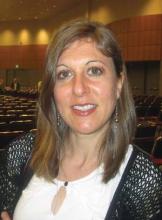SAN DIEGO – Researchers at Johns Hopkins University are working on a better way to detect fungal meningitis, according to lead investigator, Dr. Jennifer Lyons.
The efforts come in the wake of a recent nationwide outbreak in which hundreds of people were sickened and dozens died from spinal steroid injections contaminated with environmental fungi.
"Many patients developed serious central nervous system complications" following the shots, "but definitive fungal identification [was] elusive," Dr. Lyons and her colleagues noted in their abstract at the annual meeting of the American Academy of Neurology.
Cerebrospinal fluid (CSF) culture is the usual diagnostic test, and sometimes also a CSF polymerase-chain reaction (PCR) assay "that’s largely unvalidated. The CDC has been using it in this [recent] outbreak. It basically amplifies fungal elements, [but it has a] very, very low sensitivity. You can have an infection and be completely missed by this assay," she said in an interview, noting that less than a third of the recent cases were positive by PCR.
A better approach might be to check CSF for Beta D-glucan (BG), a protein in the cell wall of many fungi, including Candida and Aspergillus, and the organism implicated in the outbreak, Exserohilum rostratum.
The hope is that BG testing will help in "the diagnosis and therapeutic monitoring of fungal meningitis, [and that] sequential quantification could assist in determination of therapy duration," the abstract notes.
"CSF is an immune-privileged site, so you should have no BG in your CSF." Even so, "nobody [tests for it] except in research studies, said Dr. Lyons, a fellow in neuroimmunology and neurological infections at Johns Hopkins in Baltimore.
She and her colleagues used the Fungitell assay (Beacon Diagnostic Laboratories), a serum BG test, to check for BG in CSF samples from six patients who were sick after getting the suspect shots. They had been on voriconazole for a few days to a few weeks.
Four patients met the CDC definition for probable meningitis but had negative cultures. PCR testing in three patients was negative. All four patients with probable meningitis had detectable BG in their CSF samples.
One patient was sampled before and after 2 weeks of voriconazole treatment. Treatment corresponded with a drop in her BG titer.
Although sick, the two other patients did not meet the CDC’s criteria for probable meningitis. They had no detectable BG in their CSF.
"For every single [fungal meningitis] case we suspected, [the test] was positive. That said, it’s hard to hang your hat on this. We have a very small N; this is just an observation," Dr. Lyons said.
"The next step is to validate the assay by defining cutoff values and false positives. We are trying to get something in the works," she said.
Dr. Lyons said she has no relevant commercial disclosures.


